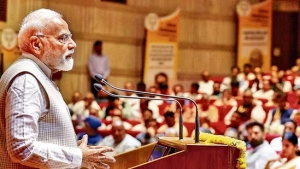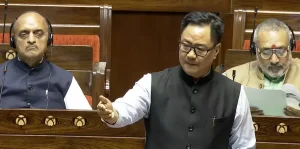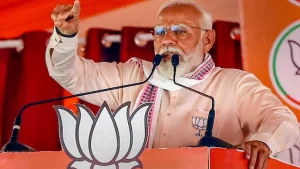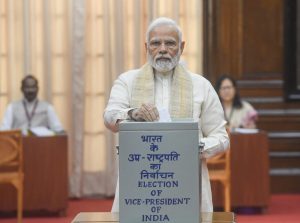New Delhi – Prime Minister Narendra Modi has instructed National Democratic Alliance (NDA) lawmakers to transform the promotion of Indian-made goods into a comprehensive swadeshi movement, emphasizing the need to organize ‘Swadeshi Melas’ in their constituencies to boost indigenous products. This directive comes as India faces economic challenges from international trade pressures and seeks to strengthen its domestic manufacturing capabilities.
During the second day of the Karyashala workshop for lawmakers on Monday, Modi outlined his vision for making the swadeshi movement a nationwide phenomenon. The Prime Minister emphasized that strengthening India’s manufacturing sector and bolstering self-reliance campaigns are crucial for overcoming current economic challenges and achieving long-term development goals.
Strategic Timing with Upcoming Festive Season

Modi specifically highlighted the upcoming festive season as the most opportune time to amplify the swadeshi movement. Beginning with the Navaratra festival on September 22, the Prime Minister identified this period as particularly auspicious for promoting Indian-made goods among consumers who are already in a purchasing mindset during festivals.
According to lawmakers present at the meeting, Modi has previously advocated being ‘vocal for local’ during Diwali and other festivals, but this time he specifically asked MPs to significantly amplify their efforts to promote indigenous products. The swadeshi movement’s integration with festive celebrations represents a strategic approach to maximize consumer engagement and cultural resonance.
The Prime Minister’s emphasis on festival timing reflects an understanding that consumer behavior during these periods can significantly impact the success of the swadeshi movement. By aligning promotional activities with traditional celebrations, the initiative aims to create deeper emotional connections between consumers and Indian products.
Response to International Trade Challenges
The push for an intensified swadeshi movement comes in direct response to high tariffs imposed by the United States and their anticipated impact on Indian businesses. Modi’s directive to NDA MPs represents a proactive strategy to reduce dependency on international markets while building domestic resilience against external economic pressures.


Union Minister Kiren Rijiju clarified that while the swadeshi movement addresses external challenges, it is not specifically targeted at any particular country. He emphasized that as India emerges as a strong nation, becoming ‘aatmanirbhar’ (self-reliant) is essential for continued progress toward developed nation status.
This approach through the swadeshi movement demonstrates India’s strategic pivot toward domestic economic strengthening while maintaining diplomatic balance in international relations. The focus remains on internal capacity building rather than confrontational trade policies.
GST Reforms Integration with Swadeshi Movement


Modi connected the swadeshi movement with recent Goods and Services Tax reforms, explaining how these changes will create positive impacts for domestic manufacturers and consumers. The Prime Minister emphasized that traders must ensure GST reform benefits are passed on to common citizens, making the swadeshi movement more economically viable for average consumers.
To support this integration, Modi instructed MPs to organize awareness campaigns ensuring both consumers and traders understand the GST reforms’ implications. This educational component of the swadeshi movement aims to maximize the policy changes’ effectiveness in promoting Indian goods.
The Prime Minister warned against complacency regarding GST reforms, urging MPs to maintain ground-level awareness and focus on consumer protection while promoting the swadeshi movement. This balanced approach ensures that domestic product promotion doesn’t compromise consumer interests or market fairness.
Practical Implementation Through Trader Engagement
Modi outlined specific implementation strategies for the swadeshi movement, including organizing ‘Vyapari Sammelan’ (trader meetings) in each constituency. These gatherings will ensure traders understand their responsibilities in following reformed laws and passing benefits to consumers while supporting indigenous products.
The swadeshi movement’s success depends heavily on trader cooperation and compliance with new regulations. By directly engaging with business communities, MPs can address concerns, provide clarifications, and build support networks for Indian goods promotion.
This grassroots approach to the swadeshi movement recognizes that lasting change requires buy-in from all stakeholders in the supply chain, from manufacturers to retailers to end consumers.
Vice Presidential Election and Administrative Duties


Beyond the swadeshi movement, Modi addressed the upcoming vice-presidential election, instructing MPs to follow correct voting procedures. He emphasized that parliamentary mistakes during polling reflect poorly on lawmakers’ competence and professionalism.
The Prime Minister, scheduled to cast the first vote on Tuesday, will subsequently visit flood-affected states of Punjab and Himachal Pradesh, demonstrating the government’s commitment to addressing multiple priorities simultaneously.
Long-term Vision for Economic Independence
The swadeshi movement represents more than immediate economic relief; it embodies India’s long-term vision for comprehensive self-reliance. By mobilizing political leadership at the constituency level, the initiative aims to create sustainable demand for Indian products while building manufacturing capabilities.
This comprehensive approach to the swadeshi movement acknowledges that economic independence requires coordinated efforts across political, business, and consumer sectors, supported by favorable policy frameworks and cultural alignment with national development goals.

